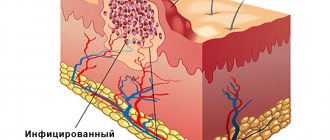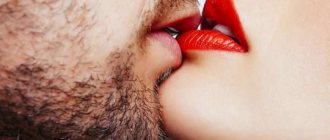What is atheroma
Atheroma is a benign growth of tissue on which increased sweating from the sebaceous gland is observed. A capsule is formed around the fat content. The formation is also called a “skin cyst” because it develops in the dermis, the last layer of skin.
They are most often noticeable on the face, on the back and behind the ears, although they can appear anywhere. Cysts are elastic to the touch and can be of very different sizes - from 5 mm. Only inflamed formations are painful - in other cases they do not cause discomfort, which is why the patient is not interested in the cost of removing atheroma. Once inflamed, the cyst increases in size, turns red, looks like a pimple and causes pain.
Treatment of atheromas
Atheroma is a benign volumetric formation of skin and subcutaneous fat. Atheroma grows from the sebaceous gland. In its embryonic state, atheroma is presented as a sebaceous gland cyst, which is gradually filled with dead organic contents. The accumulation process begins as a result of blockage of the excretory ducts of the sebaceous glands.
At the very beginning of the development of the disease, you can feel a small formation under the skin that moves along with the skin. If the atheroma is not inflamed, then it is painless and the skin over it has a normal color. Atheroma can appear on any part of the body, but there are places where it appears most often. This is the scalp, earlobes, and back.
Very often, atheroma is confused with lipoma (popularly known as fatty tissue) and fibroids. Externally, lipomas are almost impossible to distinguish from atheroma. The difference between atheroma is the presence of an opening in the excretory duct of the sebaceous gland (not always visible), and atheromas often become inflamed and fester. If you squeeze out the contents of the atheroma yourself, you will get whitish contents of an unpleasant color.
Diagnostics
Establishing a diagnosis is not difficult for an experienced surgeon. Atheroma is presented as a tumor-like formation located under the skin and associated with it. On the surface of the tumor, a small opening of the excretory duct of the sebaceous gland is determined; in the case of inflammation of the atheroma, there will be redness and pain over the formation.
Treatment
There are several approaches to treating atheroma.
The method of treatment depends on the inflammation of the atheroma:
- The most ideal is to remove atheroma when there are no signs of inflammation. In this case, complete removal of the atheroma with the capsule is possible and the risk of relapse is much lower.
- If minor signs of inflammation are detected, it is possible to begin a course of anti-inflammatory therapy and relieve the inflammation completely. After inflammation subsides, surgical treatment is performed. However, it must be borne in mind that the inflammation can quickly progress into the phase of purulent inflammation and in this case it is necessary to undergo emergency surgery. Therefore, if you have signs of inflammation (pain, redness), you should urgently consult a surgeon.
- If you have signs of obvious inflammation (throbbing severe pain, swelling, redness), urgent surgery is necessary. During the operation, an incision is made, purulent contents are released, and drainage is installed in the wound. After surgery in the phase of purulent inflammation, it is extremely rare to remove the tumor along with the capsule. Therefore, a relapse is possible in the future.
What about lipoma?
This benign formation consists of adipocytes (fat cells) and is located under the skin. Sometimes under its mask hides a much more insidious pathology of a malignant nature - liposarcoma. Lipomas are also painless and round in shape, but they are firmer to the touch. They appear, as a rule, on the back and neck, on the arms and shoulders, and less often on internal organs.
Suddenly, a person discovers a flat lump under his skin with a soft or spongy texture that moves easily without causing pain or discomfort. Few people in such cases are in a hurry to find out the prices for lipoma removal, unless its size or location causes concern. After injury or tissue damage, the cyst can grow, and it occurs mainly in older age groups.
Hygroma treatment
Hygroma is a benign cystic formation of the synovial bursa associated with the joint.
Clinically, this is a tumor of a round shape, dense consistency, covered with normal skin, with a diameter of 0.5 to 3 cm, inactive, as it is fixed at the base.
There is no clear view of the cause. There is a connection with injuries and excessive physical exertion, but in some cases, hygroma appears for no apparent reason. In this case, a slight bulge of the skin forms, as if there is a pea or cherry inside.
The favorite localization of the formation is the area of the wrist joint, and it is in this area that it often causes discomfort. Although it happens that it appears in other places.
Since the hygroma is associated with the joint, it happens that fluid flows into its cavity. Then for some time it may seem that the formation has disappeared, but, as a rule, after some time it appears again.
Hygroma can exist for a long time without causing any discomfort. Many people live with this education all their lives and do not pay any attention to it. Surgery should be considered in cases where the hygroma creates an unaesthetic appearance, causes inconvenience, causes pain during movement, or in case of its active growth.
Treatment of hygroma
Experience in treating hygroma indicates that conservative treatment methods are ineffective and in the vast majority of cases produce relapses.
An absolutely terrible and painful method is crushing the hygroma. In this case, the liquid is forced into the joint cavity, or the membrane of the hygroma ruptures and the contents pour into the tissue. Over time, at best, everything returns to normal. At worst, an inflammatory reaction may develop in the area of the injured hygroma, leading to suppuration. After crushing, sooner or later the membrane heals, restores its tightness, and the hygroma appears again.
They try to puncture the hygromas - suck out the contents with a syringe and inject various substances into it. In this case, the cavity collapses for a while, but the shell itself does not disappear anywhere, and the liquid sooner or later accumulates again.
The most effective surgical treatment of hygroma involves complete excision of the ganglion.
Radical surgery is the main guarantee of the absence of relapse.
The operation is performed under local anesthesia, lasts 20-30 minutes, the sutures are removed 7-10 days after the operation. For large sizes and complex localization, the operation is performed under anesthesia.
What happens if unqualified specialists undertake the operation?
Only the upper, most accessible part of the formation is isolated, which is removed after evacuation of the fluid that filled the hygroma. Most of the shell remains deep in the tissue. The first 2-3 months after the operation create the appearance of a favorable outcome of the treatment, but as the remaining part scars, the tightness of the hygroma is restored, and fluid begins to accumulate in it again.
In fact, instead of a good, beautiful operation, only the appearance of intervention is created.
Therefore, beware if you are told that the operation is “nonsense, for 5 minutes.” It takes much more time to thoroughly isolate the hygroma. The operation is very delicate and painstaking. If the hygroma is not completely isolated from the surrounding tissues to the very point where its pedicle communicates with the joint, the risk of relapse increases many times over.
Guaranteed treatment effectiveness is achieved with modern equipment and more than 15 years of experience of a highly qualified surgeon.
Where can you remove atheroma and lipoma?
Even the simplest surgery should only be performed by an experienced physician and performed in a facility that is responsible for the end result and has a genuine concern for the health and safety of the patient. The Femina women's health center in Simferopol fully meets the necessary requirements, whose clients can expect:
- doctors of the highest and first medical categories who know exactly how a lipoma differs from an atheroma and are able to quickly diagnose these neoplasms;
- best-practice laboratory and surgical conditions;
- Convenient work hours and competitive prices for the full range of services.
Ask the administrator of the Femina clinic any questions you have and make an appointment by phone, online chat, or email right now!
Lipoma
A lipoma is a tumor formation characterized by a benign course. The source of its development is adipose tissue, and the cause of its formation has not yet been reliably established. So, it may be a violation in the genotype, which causes a deficiency of the lipase enzyme involved in the dissolution of fats.
Externally, a lipoma looks like a contouring, mobile tumor with an elastic consistency. Localization - any part of the body other than the feet and palms. In itself, it is safe, does not grow into adjacent organs, does not hurt or metastasize, is not prone to inflammation, but is perceived by humans as a cosmetic defect. In addition, sometimes the growing wen compresses the nerve trunks of neighboring tissues, which causes pain.
Diagnostics
A reliable non-invasive method for studying this tumor is ultrasound, and if the diagnosis is not obvious, a diagnostic puncture is used.
Lipoma treatment
Small lipomas that are not prone to growth and do not create problems in everyday life can be left alone. If the tumor grows, it is removed surgically using local anesthesia. Healing of a postoperative wound takes up to 2 weeks.
Removal of atheroma, hygroma, lipoma is the only radical method of getting rid of the disease
Skin is one of the most important organs. In addition to its protective function, it actively participates in the metabolic processes of the body. Blockage of the sebaceous glands or skin pores is fraught with the accumulation of fat, sebaceous or other masses and, as a result, the development of various neoplasms. Neoplasms that arise as a result of blockage of glands and accumulation of fluids include atheromas, lipomas and hygromas. Atheroma
This type of neoplasm occurs as a result of blockage of the sebaceous gland duct. Sebum, unable to come out freely, accumulates inside the fibrous capsule, putting pressure on its walls from the inside. The neoplasm has clear contours, can be easily palpated, and can arbitrarily change in size depending on external factors. Most often, atheromas are localized in areas of increased concentration of sebaceous glands, i.e. on the back, head, neck, face and genital area.
Typically, atheroma does not cause any unpleasant sensations to its owner, but significantly reduces the aesthetic appeal. In rare cases, pain, redness, a feeling of skin tension, and an unpleasant odor are noted.
Hygroma
This type of tumor affects the wrist joint more often than other parts of the body. Hygroma is a subcutaneous accumulation of fluid in a dense capsule. Often the contents of the hygroma are fibrous and/or serous fluid of the joint.
The tumor does not cause any discomfort to the patient and grows very slowly in size. The reasons for the development of hygroma include:
- traumatic joint injuries and their consequences;
- inflammatory processes in joint tissues;
- prolonged physical activity, repetitive movements;
- genetic (hereditary) predisposition.
As the hygroma grows, it can cause difficulty in moving the hand and cause serious discomfort.
Lipoma
This type of neoplasm has a popular name - wen. This benign neoplasm occurs when a pore is blocked and fatty tissue accumulates. It has a soft consistency and can be easily felt. Most often found on the back, hips, shoulders, less often on the neck and arms. Lipoma can reach impressive sizes and cause limited mobility or deterioration of the patient’s aesthetic appearance.
Removal of atheroma, hygroma, lipoma
The most reliable and proven way to get rid of benign neoplasms of the human skin is their surgical removal. Before starting treatment, the specialist must make sure that the neoplasm does not pose a threat to the patient’s health and is 100% benign. After this, an operation is performed to remove the formation. The surgical procedure is selected individually for each specific case.
During the operation, the skin is excised and the contents of the tumor capsule are exfoliated. Modern methods of surgical removal of skin tumors, along with the use of the latest surgical equipment, allow surgical intervention to be performed in the shortest possible time. The operations are low-traumatic and are performed under local anesthesia. After surgery, a specialist may recommend certain, often antibacterial, therapy. The healing period varies depending on the location and degree of development of the tumor. After removal of the formations, no traces of their presence remain on the patient’s body.
Even small abrasions and bruises of existing benign formations (atheromas, lipomas, hygromas) can result in serious inflammation of the soft tissues. Through the defect, the formation can become infected, causing inflammation, swelling, and redness of the skin. The correct action in all situations is to immediately seek qualified medical help. If inflammatory processes occur, it may be necessary to open the cavity of the formation, and radical removal will be postponed to the second stage, when the inflammatory process subsides. There is no need to allow complications to develop. Formations that increase in size and cause discomfort must be removed, preventing inflammation from occurring.
Having chosen the WikiMed clinic for manipulation (removal of hygroma, atheroma, lipoma, opening of felon) on the day of your visit, you can count on a free consultation with a surgeon.
Source of the article: https://medihost.ru/?show=news&id=2767










